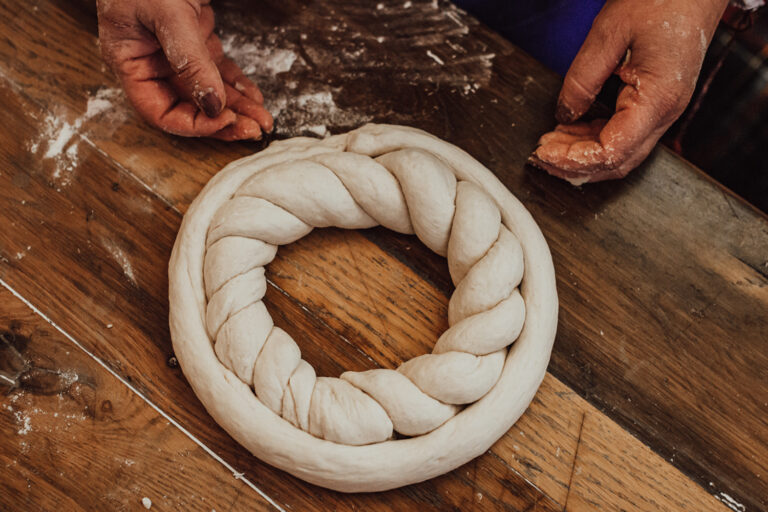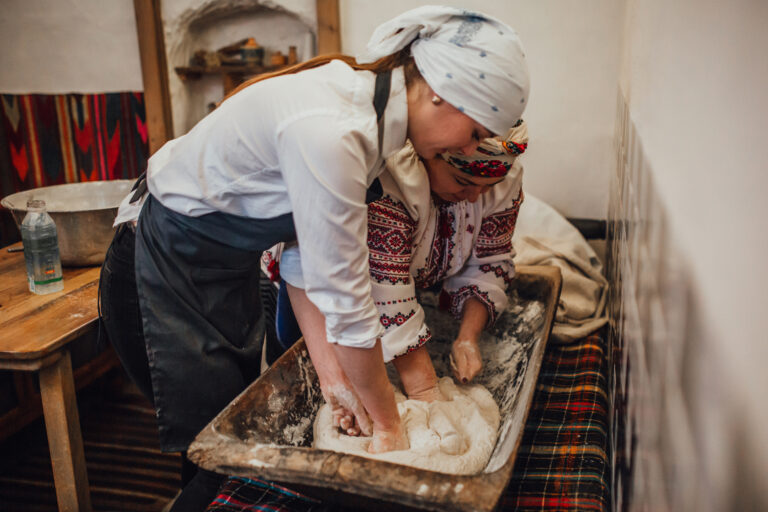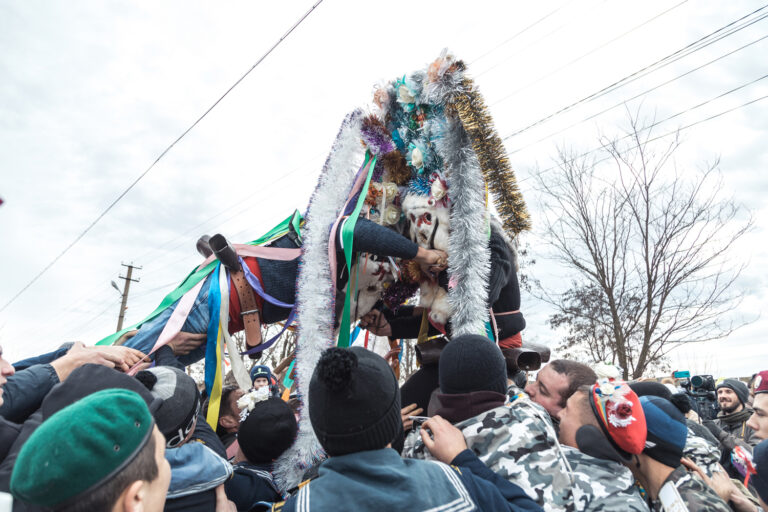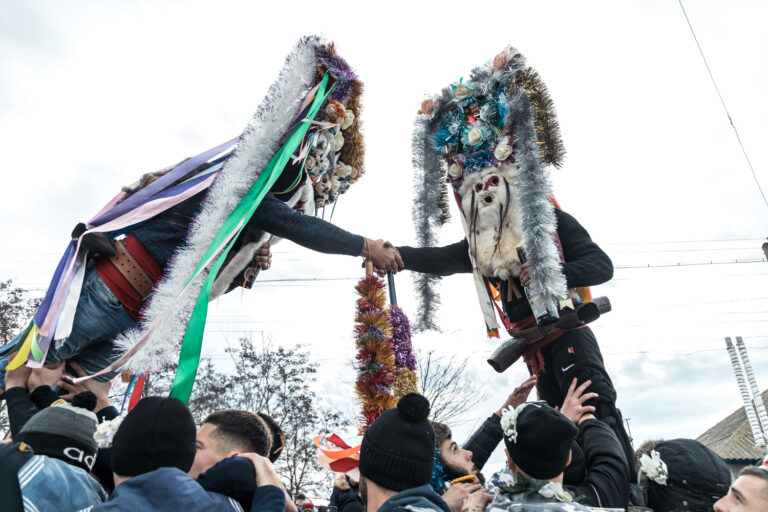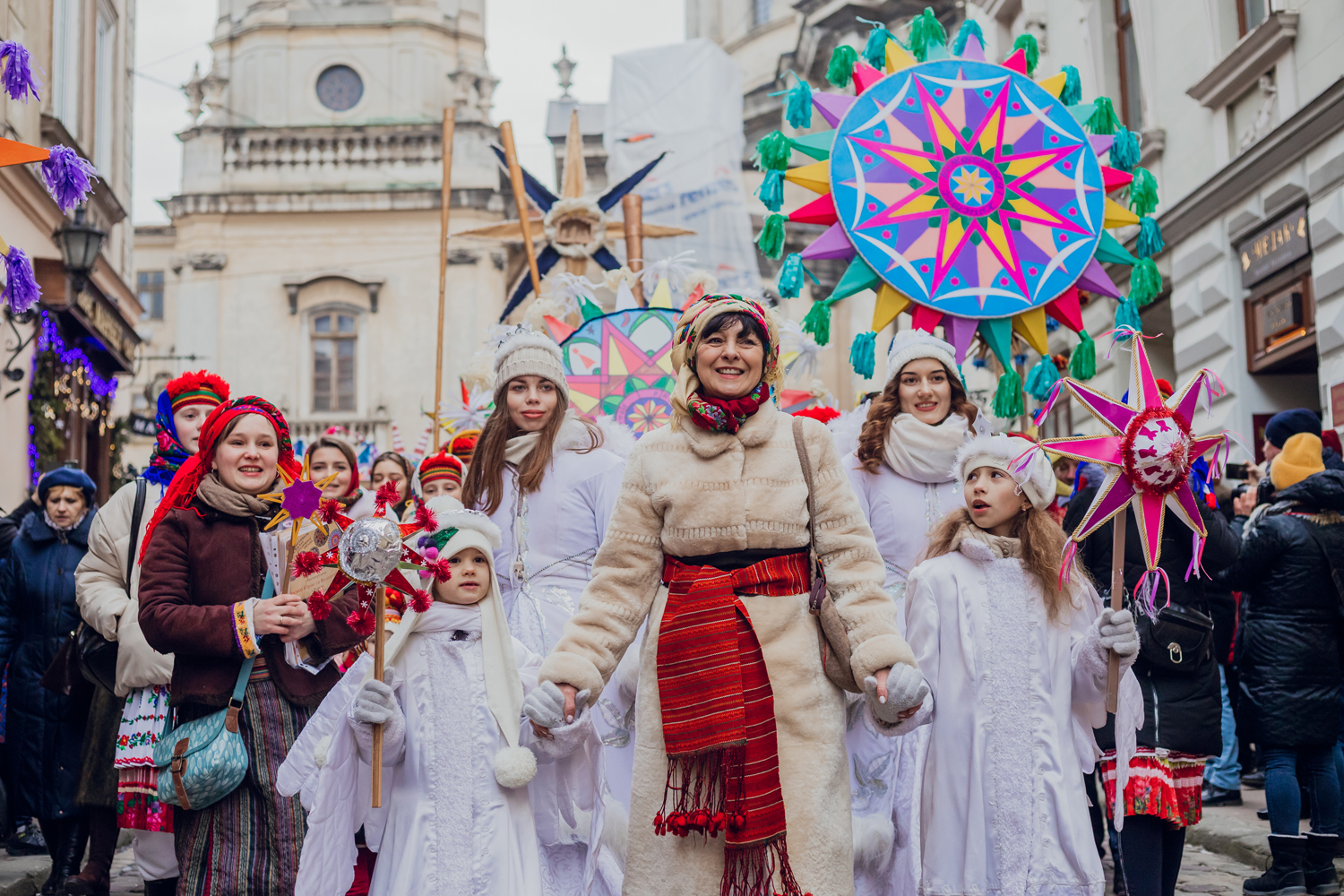
December and January in Ukraine are winter holiday months, brimming with colourful costumes, memorable events, and abundant group singing. One of these holidays is Christmas, and its celebration traditions are interwoven with rites from pre-Christian times.
In almost all of the world’s Christian countries, Christmas is celebrated on 25 December, coinciding with the winter solstice days. In pre-Christian times, it was the day of the birth of the sun, the birth of the world. Thus, pre-Christian roots can be traced in modern Christian traditions.
In Ukraine, the celebration of Christmas Eve traditionally varies according to church jurisdiction. It used to be observed either on December 24, as per the Gregorian Calendar, or on January 6, according to the Julian Calendar, the latter having been imposed during the Soviet era. In a significant shift in 2023, the Orthodox Church of Ukraine adopted the Gregorian Calendar, officially setting the Christmas celebration dates to December 24-25. Nevertheless, religious freedom allows people to celebrate Christmas in line with their respective church’s traditions or personal beliefs.
Ukrainian Christmas traditions: Christmas Eve
Christmas Eve is called Holy Evening. It is celebrated with family, in anticipation of the birth of God’s child. Christians believe that on this evening, the realms of the living and the dead converge.
Since ancient times, Christmas has been marked by performing rituals to ensure a good harvest and the well-being of the household in the coming year. A central tradition on Christmas Eve involves placing a Didukh in the home. This sheaf, made of ears of rye or wheat, is believed to bring prosperity and well-being. The completed Didukh is customarily positioned in a special corner known as the pokut — a sacred space in the house where icons are displayed and the most honoured guests are accommodated.
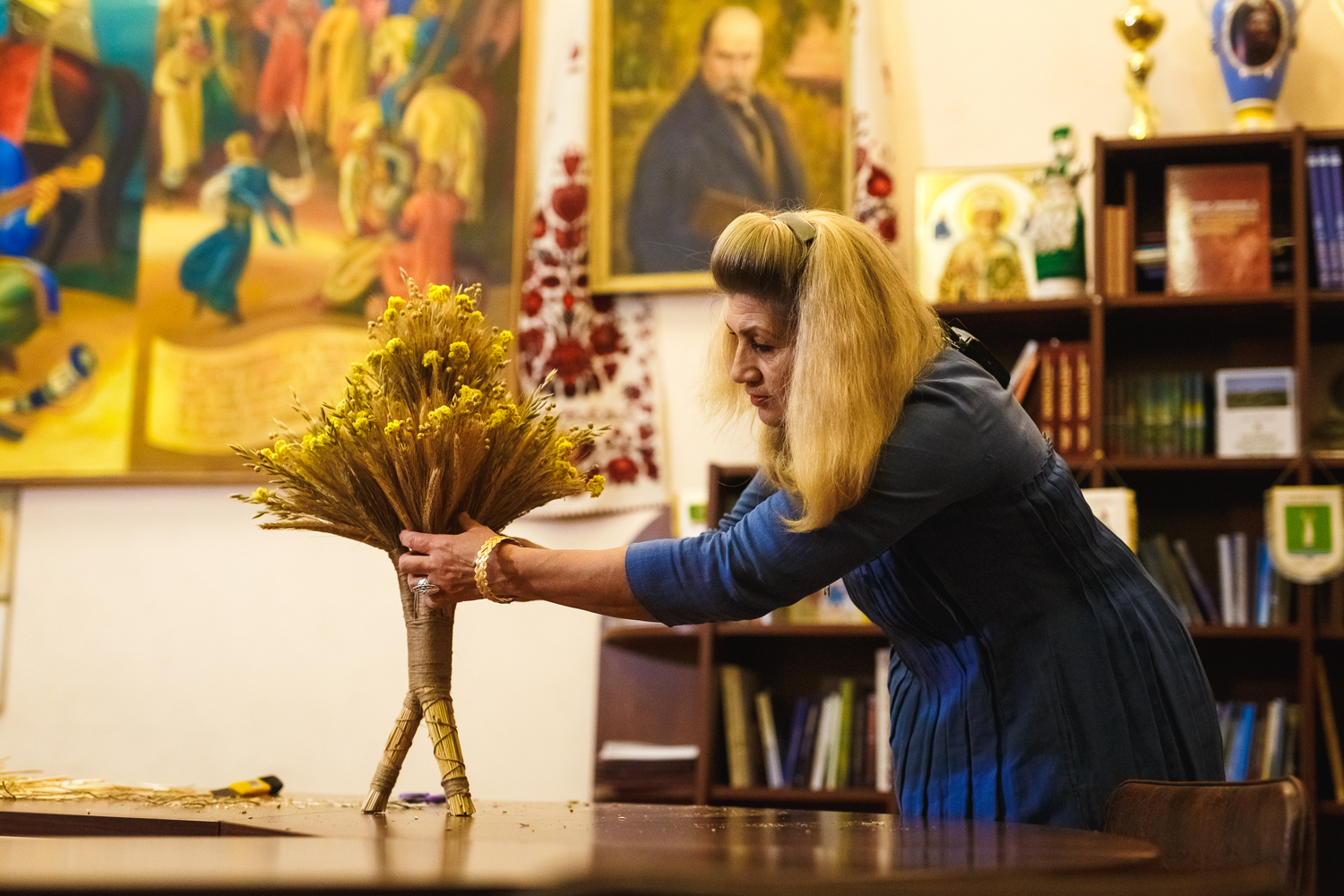
Craftswoman Olha Sakhno primarily uses rye to construct the Didukh, valuing it as a symbol of life. However, she notes that other grain crops like oats or wheat can also be used. To enhance the Didukh’s base, she adorns it with additional herbs, including flax and immortelle.
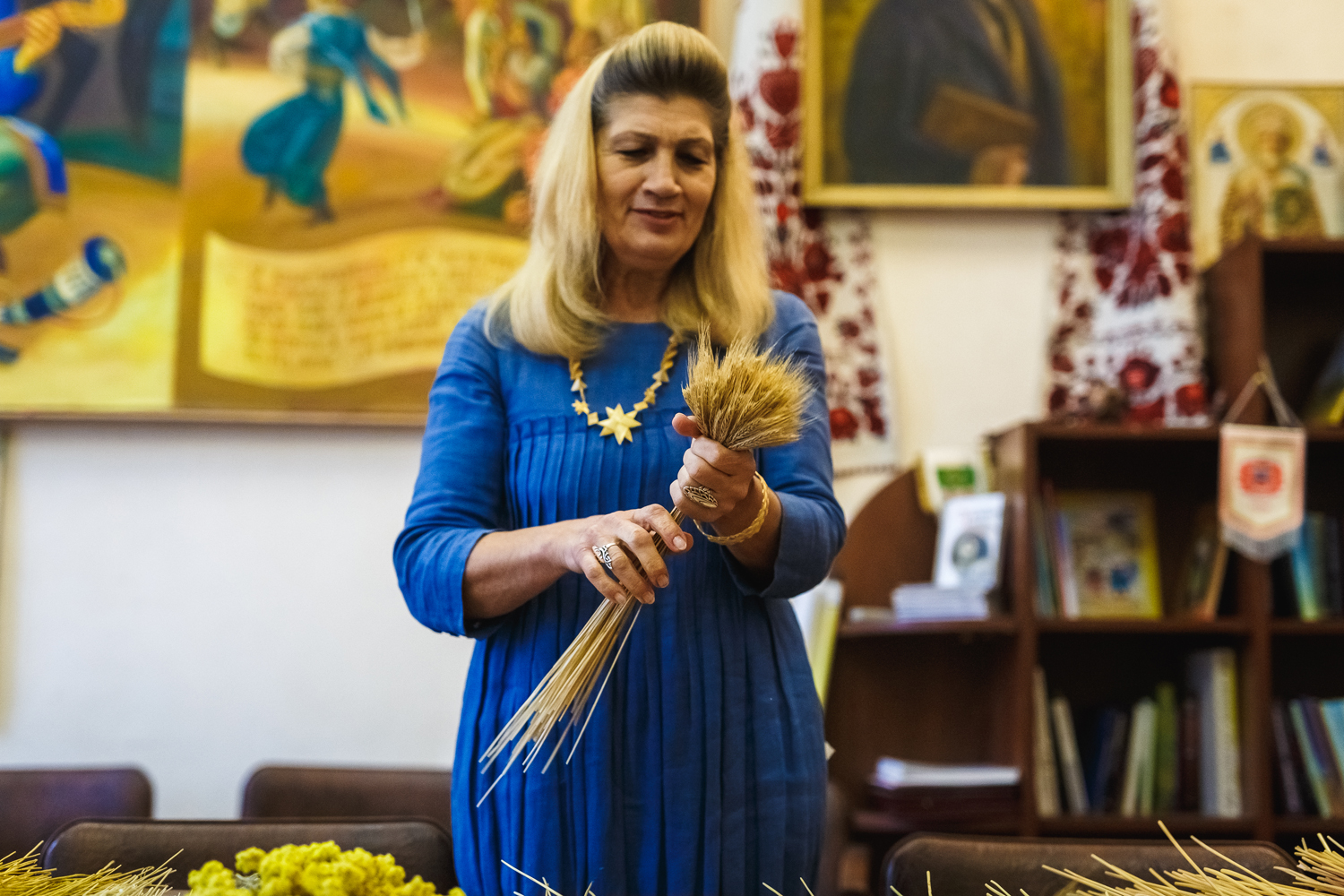
Traditionally, on the third day of Christmas or afterwards, the grains are separated from the spikelets and sown into the soil, a ritual intended to ensure a bountiful and rich harvest. In some regions, the Didukh is ceremonially burned to symbolise the disposal of all the hardships experienced over the past year. Master Olga Sakhno explains the significance:
— Symbolically, we remove a few straws, use them to smoke out all the negativity, and bid farewell to winter, driving it away. This act also purges the house of accumulated negatives — illnesses, troubles, and misunderstandings are believed to be literally expelled with the smoke.
Ukrainian Christmas Eve rituals and traditional Christmas food
When the first star appears in the sky, people sit down at a table. They have dinner only with fasting dishes because Christmas Eve is the last day of the Christmas (or Philippian) fast. The number of dishes can vary: three, seven, nine, twelve — depending on the region and the family’s wealth level.
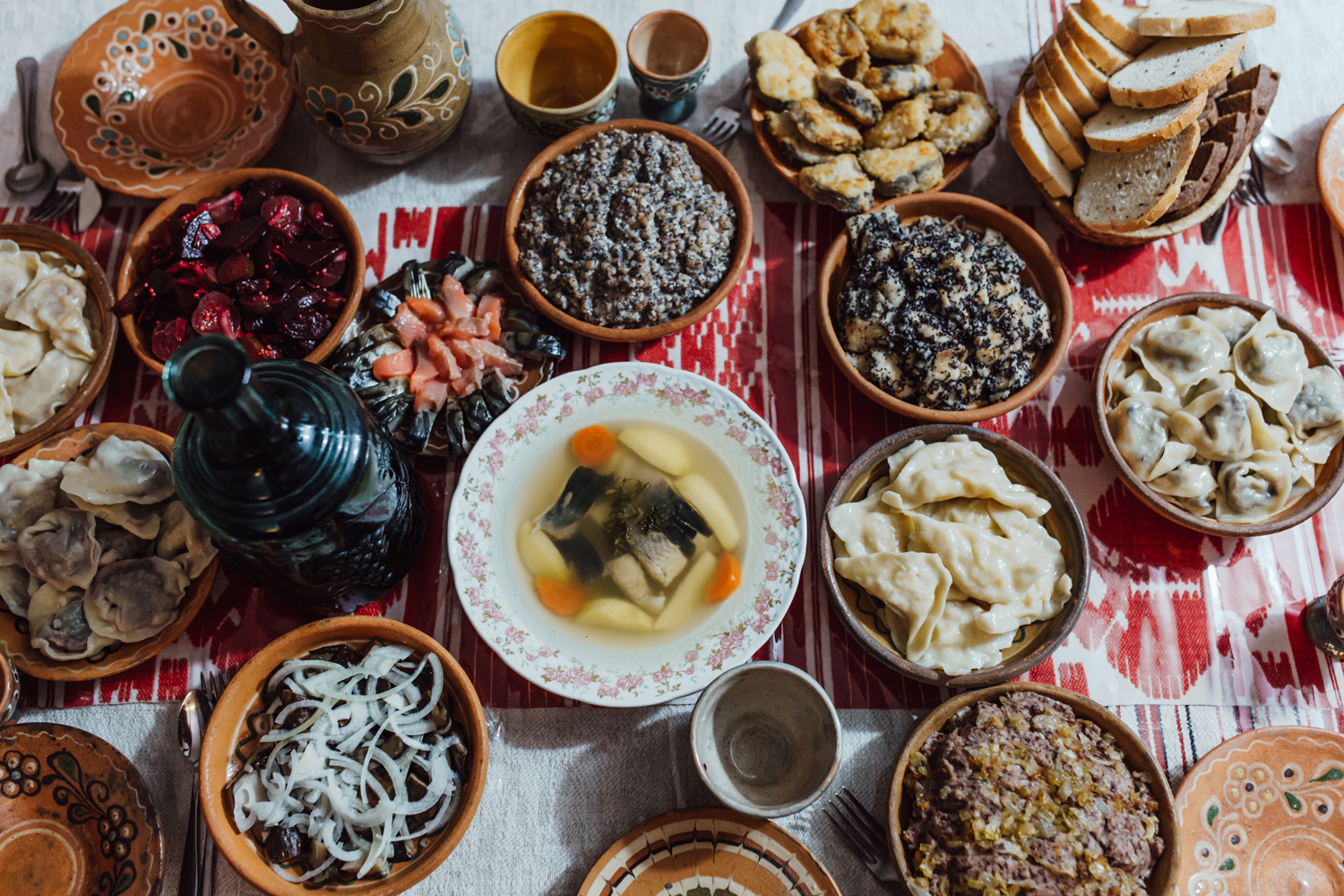
Traditional Christmas Eve food in Ukraine.
In some regions, such as Boykivshchyna, after putting bread on the table and lighting a candle, the hostess places cloves of garlic on the four corners of the table to scare away evil forces.
The main dish served on Christmas Eve is Kutia. It is porridge made from boiled wheat, poppy seeds, nuts, and honey. When wheat grains are cleaned and washed, the porridge is put to boil. Then, you add crushed poppy seeds and nuts. Honey is the last ingredient added to the porridge. Sometimes, people also add raisins or other dried fruits.
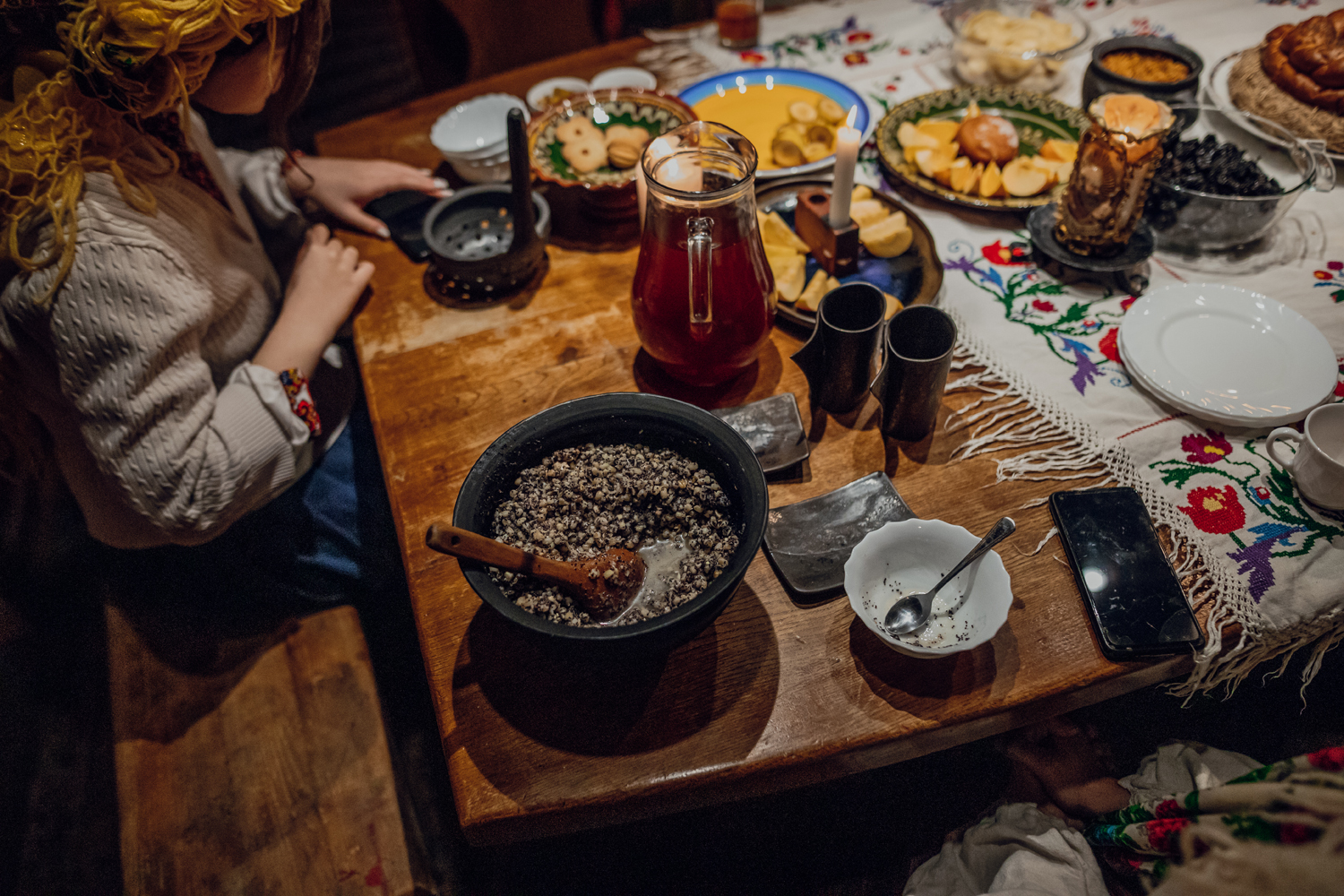
Traditional Christmas Eve food in Ukraine.
A traditional beverage served during Christmas in Ukraine is uzvar, a drink made from dried fruits. Both kutya and uzvar are considered commemorative, as they symbolically welcome the souls of the deceased to join the living for dinner.
Bread also holds significant importance, with numerous regional variations in its preparation. For instance, in the village of Shershentsi, different types of bread are prepared on Christmas Eve, each serving a specific purpose. One such type is Pomana, a ritual bread made to honour deceased family members.
The foundation of Pomana is a dough braid formed into a circle. Two additional braids are placed across it in a crosswise manner, and the gaps are filled with spikelets made from four slender dough strands. In a traditional setting, two housewives stand beside a trough carved from willow, kneading the dough with their fists. After the dough has been set aside to rise for one and a half hours, it’s then used to create the ritual bread. These breads are subsequently carried to a furnace for baking.
slideshow
Usually, on Christmas Eve, the owner’s godchildren come over with a kalach. Kalach is also a dough braid, laid out in a circle. It usually has sweets and a candle inside.
On Christmas Eve in Ukraine, people also serve lean borshch with “ears”, a kind of dumplings made from water dough and oil. The dough is divided into small pieces, rolled out, mixed with mushroom filling, and then thrown into the borshch.
Mushroom soup, lean cabbage rolls, fried or baked fish are also traditional dishes. And, of course, varenyky — a half-moon-shaped dough meal with filling. The filling can be different. Christmas-Eve dumplings are often made with cabbage or sweets — just add prunes or cherries as filling.
Christmas in Ukraine
Unlike Christmas Eve, Christmas in Ukraine is celebrated lavishly, glorifying the birth of Christ. On this day, there is lots of meat and sweets on the table: sausages, ham, gingerbread cookies, crepes, and pies with sweet and salty fillings. Christmas celebrations are accompanied by carols and nativity scenes.
Christmas carols have been a part of the holiday traditions since pre-Christian times and continue unabated to this day.
Carols are ritual songs. On Christmas Day, carolers go from house to house, singing about the birth of Christ and praising the owners and the whole family with carols. For this, carolers receive rewards from the owners, like sweets or money.
According to one theory, the word “carol” comes from the Latin word calendae, which means the first day of a month. At the beginning of the new year in ancient Rome, people sang songs wishing a rich harvest and prosperity. With the advent of Christianity, the ritual songs started glorifying Christ and the stories of the birth of the Son of God.
Thus, carols combine old ritual motifs about the creation of the world and Christian themes. New versions of carols also include folk motifs. According to the Ukrainian tradition, carols are sung separately for each member of the family, girls and boys, and even animals.
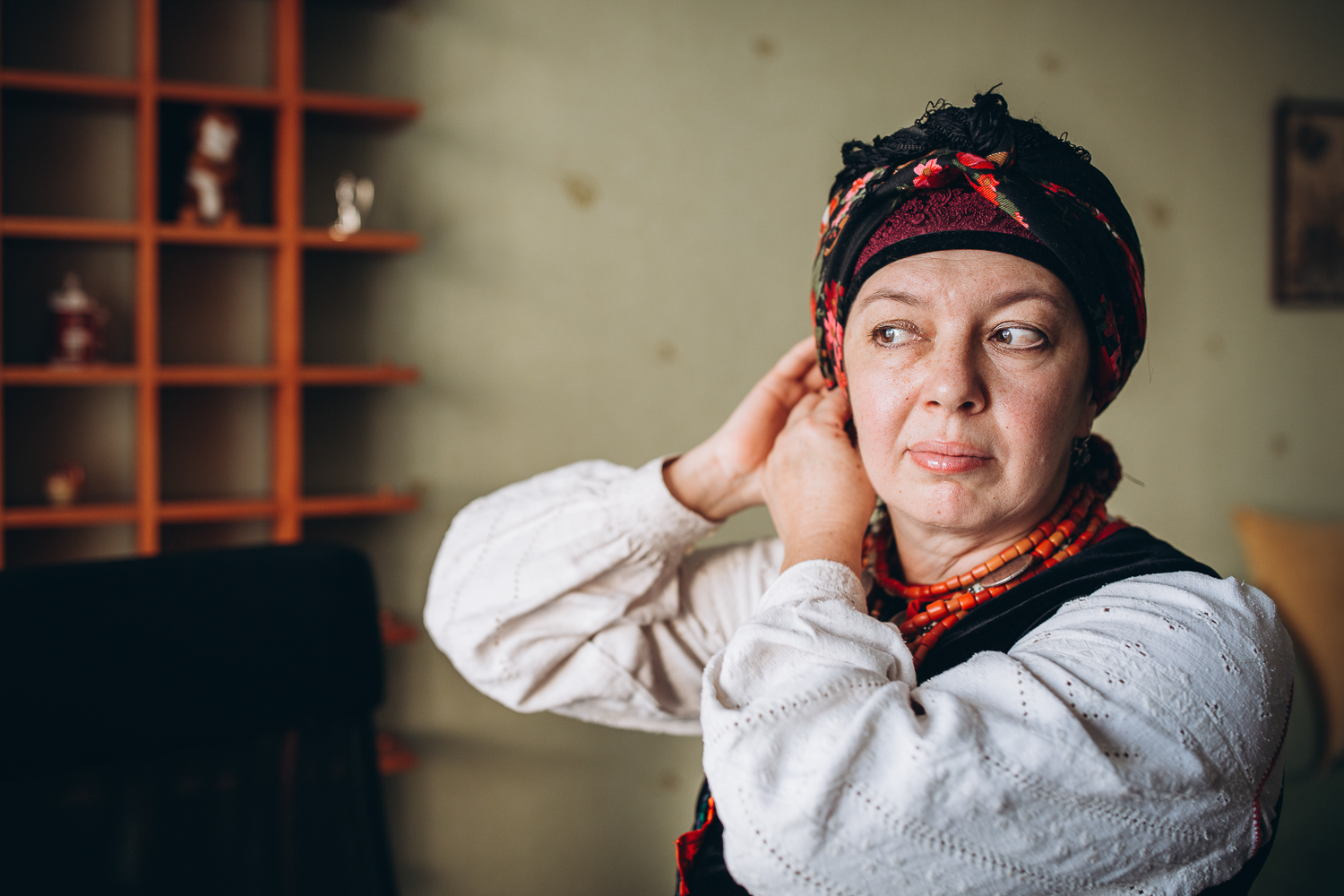
Ukrainian folklorist Halyna Lukyanets during the preparation for Christmas carolling.
Folklorist Halyna Lukyanets travelled through the villages and towns of Slobozhanshchyna and Poltava region, writing down texts of ancient carols. She shares:
— — We have recorded many “wedding” carols. There are carols both for boys and girls, and they can be about an upcoming wedding. For men, there are also military or Kozak carol versions.
Carolers traditionally walk with a star mounted on a stick, symbolising the Star of Bethlehem that heralded the birth of Christ and guided the three kings to the Son of God. The earliest records of carolling with a Christmas star can be traced back to the 17th century. Bearing the star is regarded as an honourable task, as the person carrying it is deemed the leader of the carolling group.
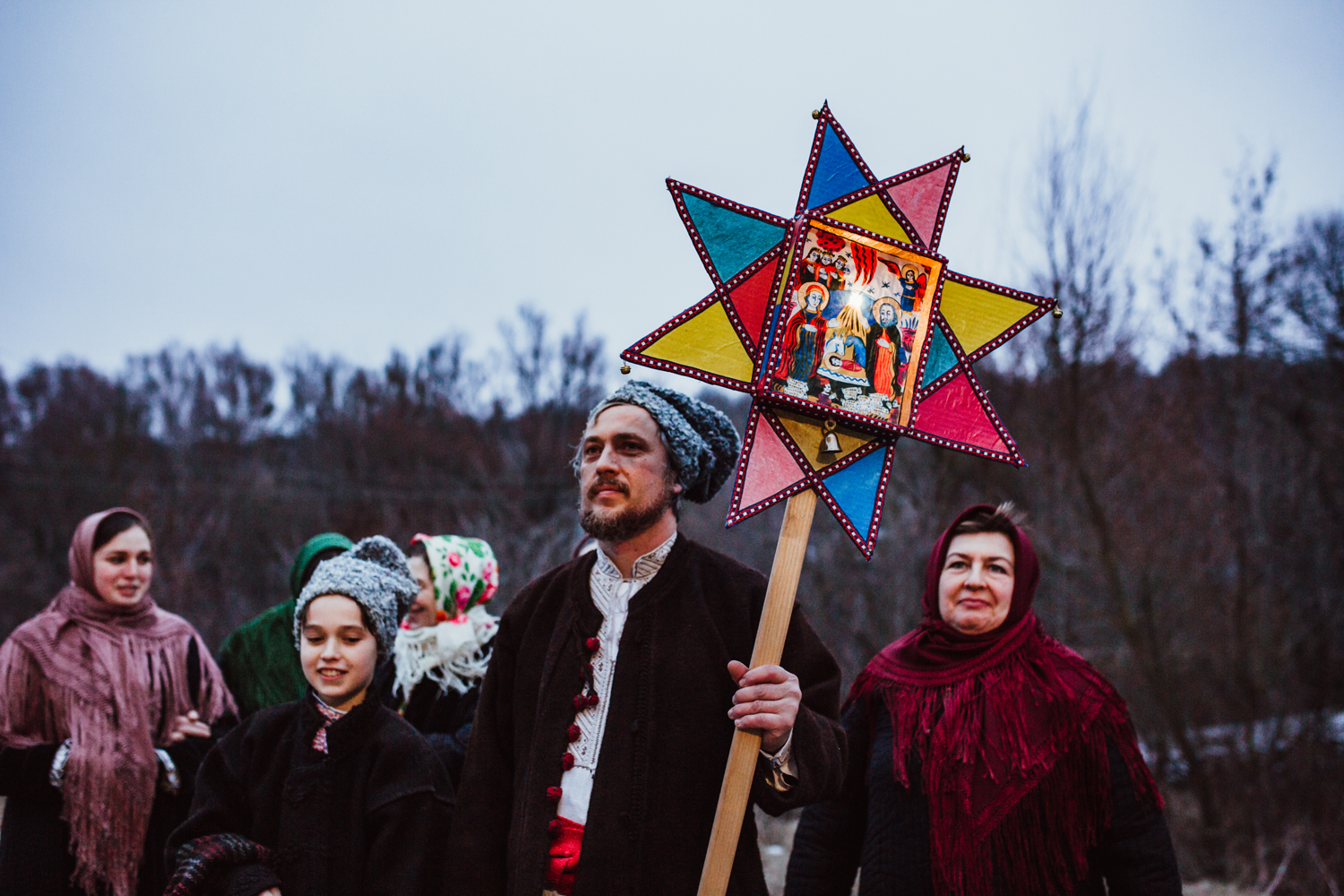
Christmas carolling in Ukraine.
Christmas star procession in Lviv, Ukraine
Throughout the city, the star procession brings a kaleidoscope of bright colours to life with each step of its participants. They carry an array of spinning Christmas stars, each uniquely crafted. Large and small, ranging from octagonal to twenty-five-angled, adorned with tassels and bells, some styled like sunflowers or decorated with intricately carved scenes depicting the birth of Jesus Christ — no two stars are alike. This vibrant spectacle is further enhanced by the melodies of musicians playing various instruments and the harmonious singing of carols by the people.
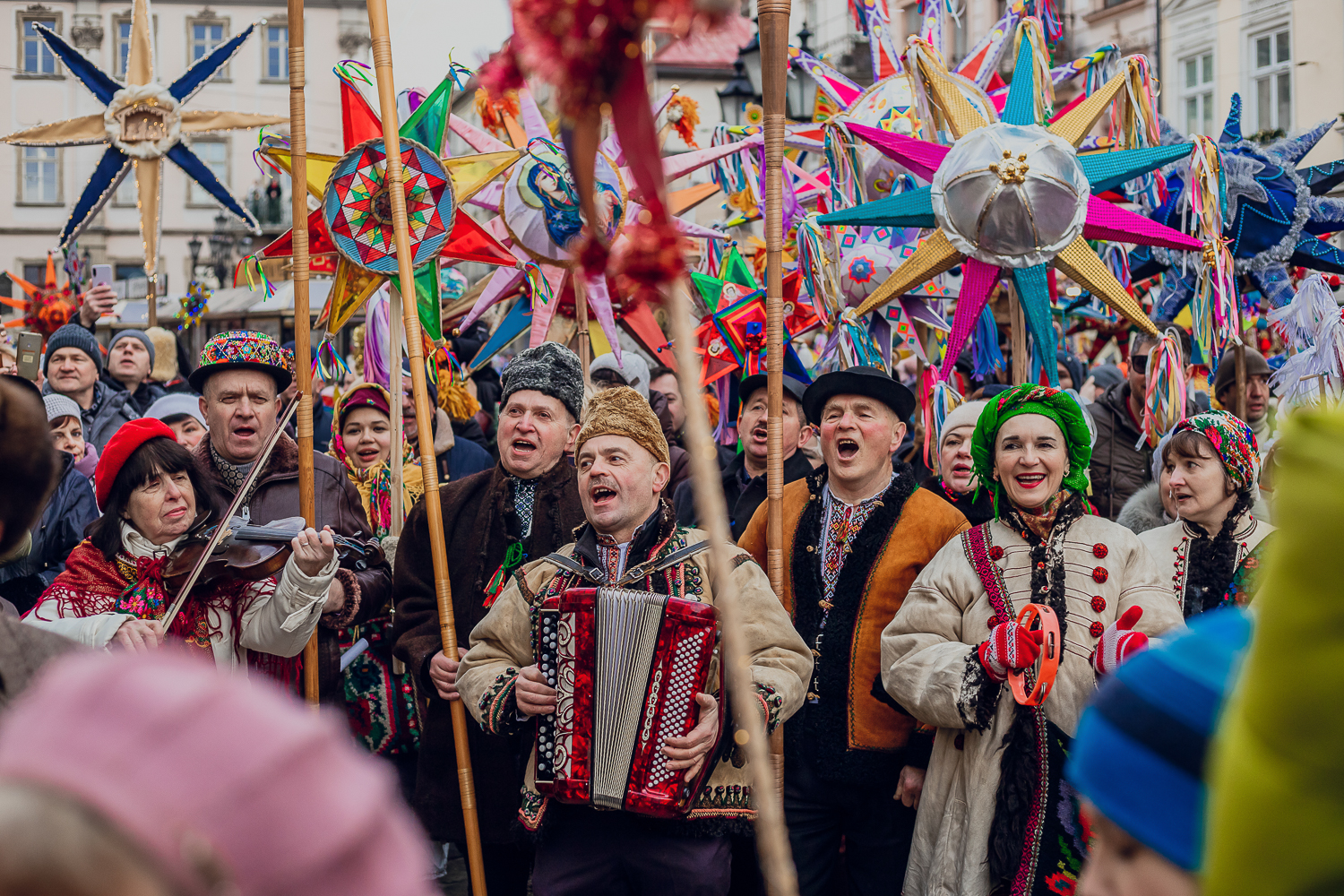
Christmas star procession in Ukraine.
Like most Christmas symbols, before the advent of Christianity, the star had a special meaning because it symbolised the Sun — the most important star for people, celebrating its arrival on the days of the winter solstice. Nowadays, stories related to the birth of Christ are often painted on the stars.
In addition, Lviv residents make traditional and thematic stars, which resonate with modern events. In 2021, a thank-you star appeared during the march for doctors who tirelessly saved people affected by the coronavirus.
Traditionally, Christmas stars are made of wood. The base of the star is strung on a stick. Craftsmen prepare two wooden circles connected by strips as a basis. The number of corners varies. An eight-angled star is most often found in Ukraine.
Christmas in the West of Ukraine, Kryvorivnya
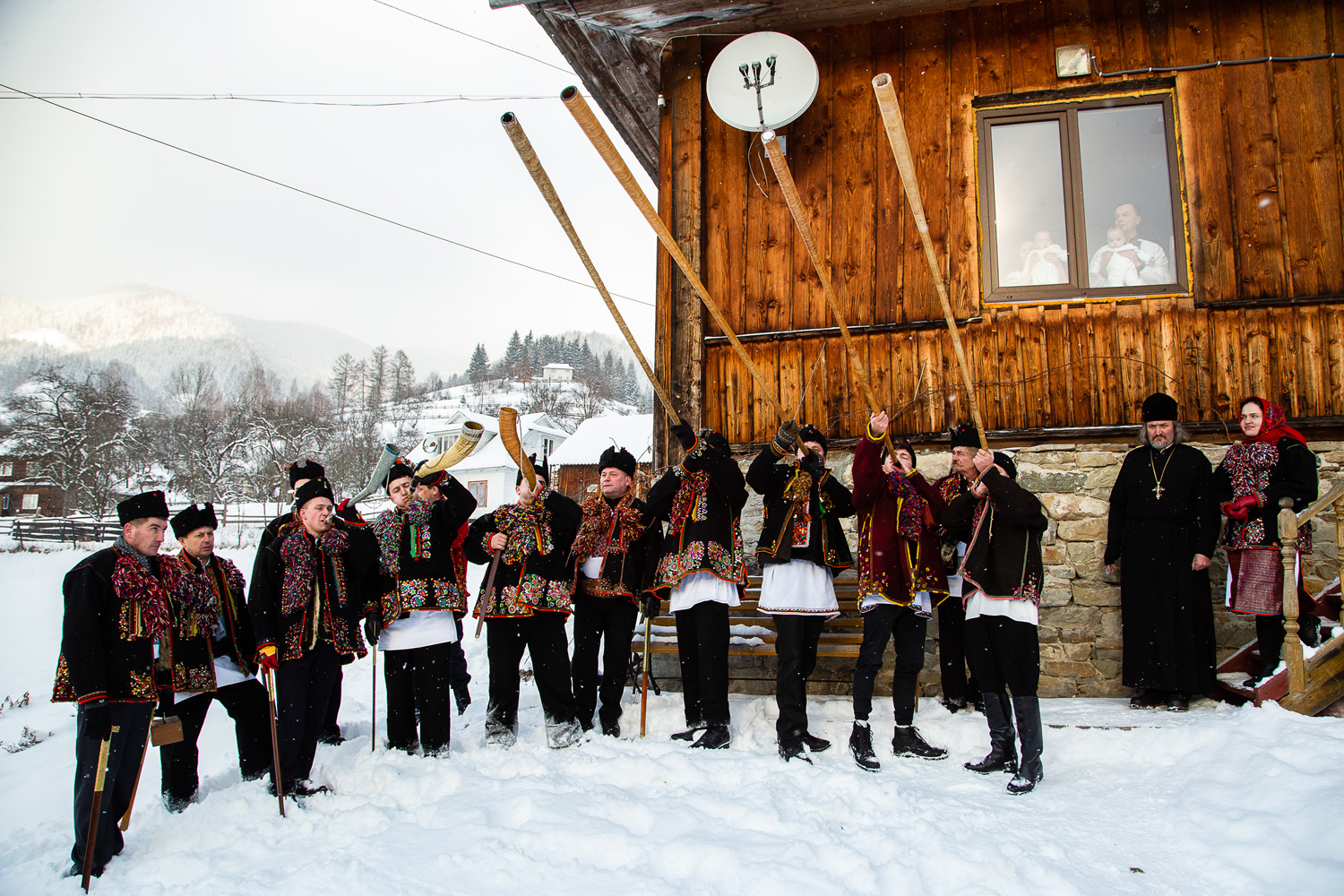
Celebration of Christmas in the village of Kryvorivnia.
In the village of Kryvorivnia, after the festive Christmas liturgy, carolers, villagers and visitors move to the church yard. The carolers form a circle, as a universal symbol of the sun, inside of which Berezas (leaders of the carol groups. — ed.) and violinists line up. And then, the event, which everyone has been waiting for all year begins.
Bartky (sharp narrow-nosed axes — ed.) rise up, as if reflecting the rhythm; the musicians blow the trembitas and horns.
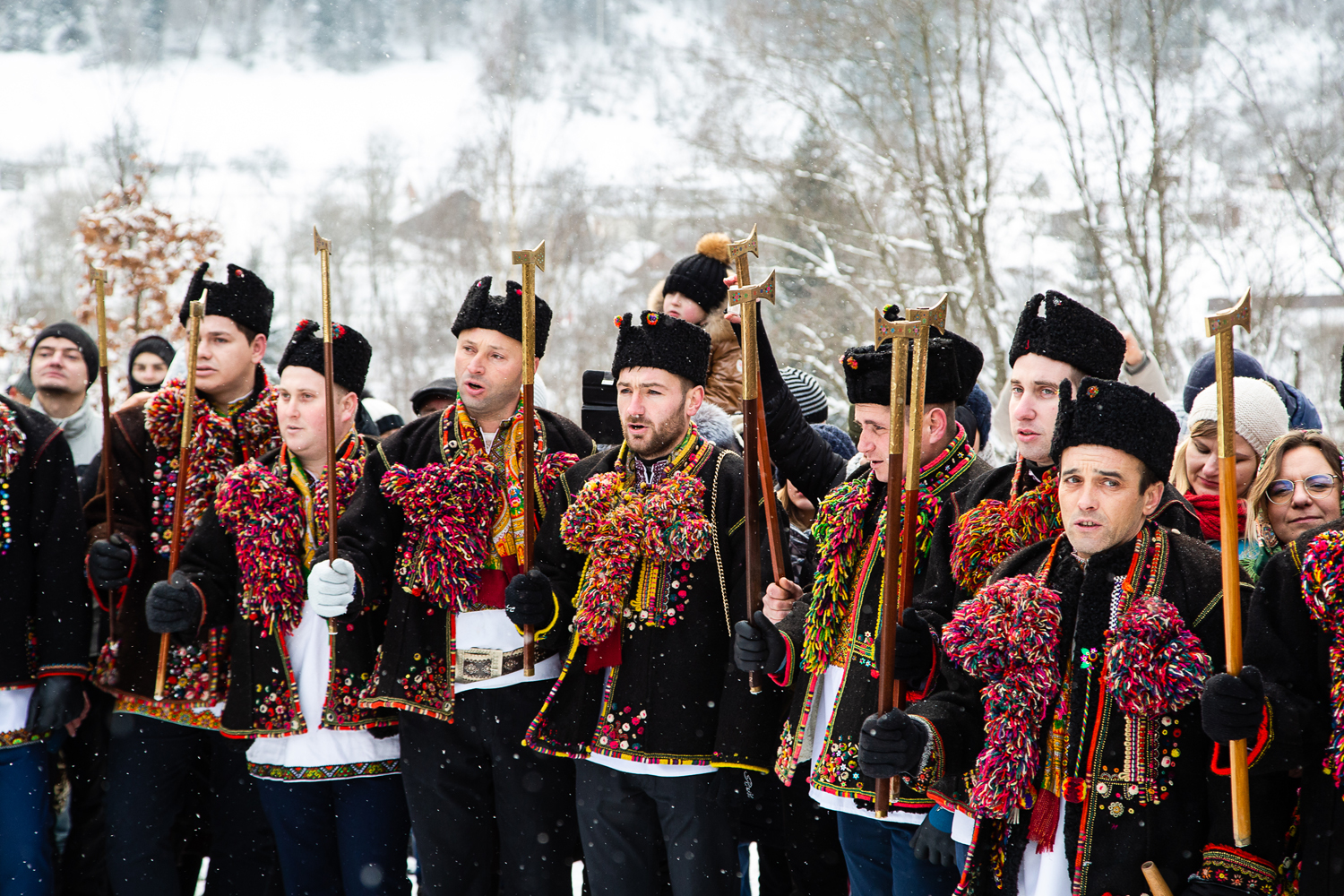
Celebration of Christmas in the village of Kryvorivnia.
The carolling in Kryvorivnya commences with a dance, where carolers engage in singing and dancing. There are as many carolling groups within the nine smaller villages of Kryvorivnya. Each group performs their carols while circling the church three times before proceeding from house to house to extend greetings to the homes and their owners. The carolling spans about two weeks, as every house must be visited, and the men involved in carolling are away from their homes during this entire period.
Trembita
Trembita is a Ukrainian folk wind instrument, shaped as a wooden 2.5-to-8-meters-long trumpet.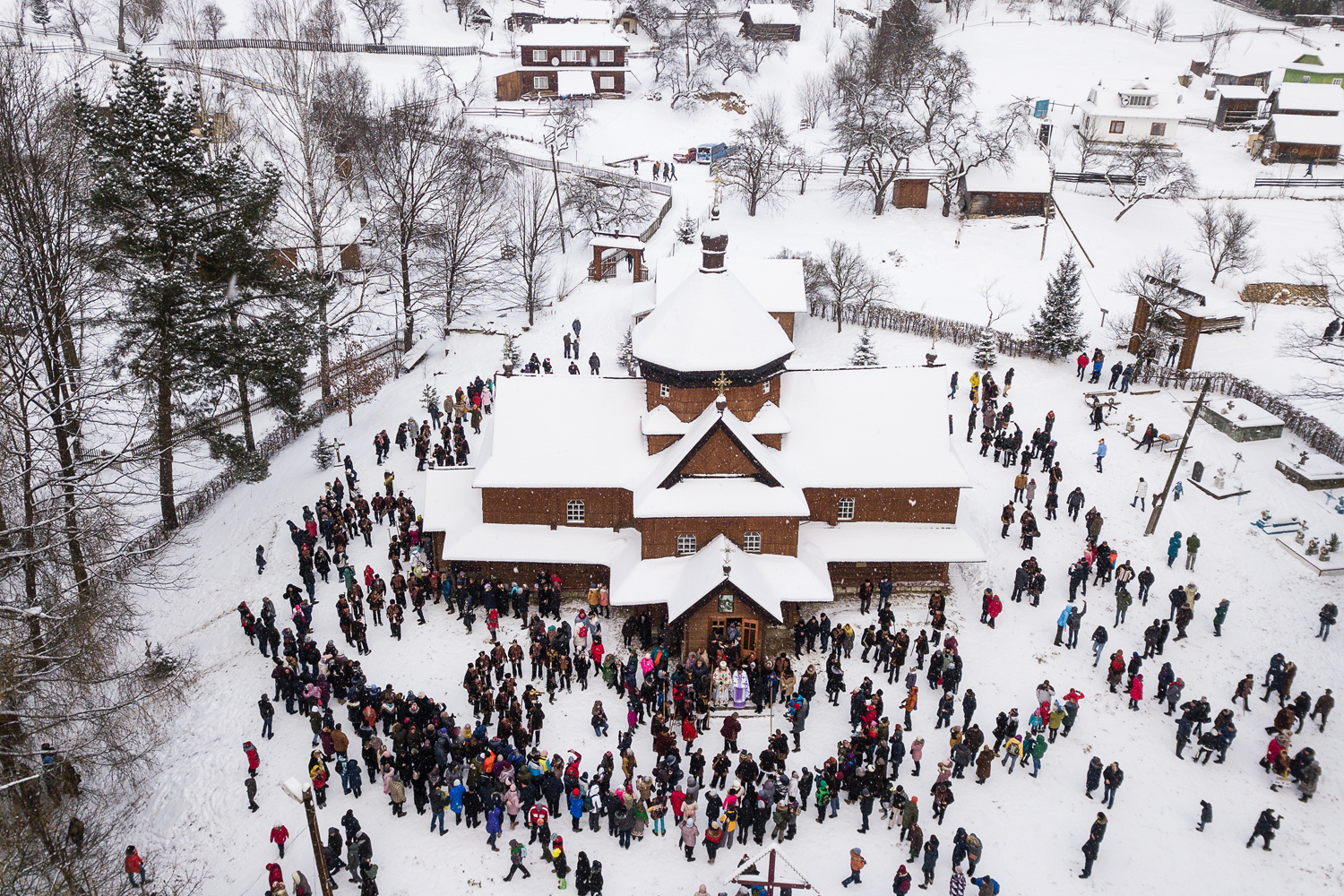
Since the onset of the war in 2014, a new tradition has emerged: one of the carolling groups makes a special journey to sing with the soldiers at the frontline.
Father Ivan Rybaruk offers his blessings to the carolers at Christmas, and the funds raised from the carolling activities are allocated for the restoration of the church, support of the army, and aid for those in need of medical treatment.

Father Ivan from Kryvorivnia.
Traditionally, Hutsul women do not go carolling with the group and do not form their own groups. This happened, probably, because of the household structure. After all, women had to take care of children and the household, and the men simply had more physical strength to survive. However, Father Ivan says that there were also cases when women went carolling.
Carols are sung differently in each house. It depends on what the owners prefer. They can carol either for a family as a whole or for each family member separately, even for each child and animal. The carols are called accordingly: “Carol for a boss,” “Carol for a girl,” “Carol for a boy.” The words of carols differ in each village and may differ even between groups.
When the carolers approach a house that no one probably lives in, they still carol so as to restore life there.
After the twelve-day carolling procession, groups gather for Rozkolyada in the house of their Bereza, where they carol for him and his family. After the carol, they drink from a special bell, thanking them for the hospitality. Bereza and the fiddler stand in the centre, and carolers dance around them every possible dance they know. They all ask God to live up to the next Christmas.
Ukrainian Christmas tradition: Vertep (Nativity Scenes)
In addition to carolling, there are nativity scenes — another form of announcing the good news. It arrived in Ukraine from the West. Nativity scenes are theatrical plays, telling the story of the birth of Jesus Christ and his rescue from the angry King Herod. In different times, nativity scenes were not only a retelling of a well-known story, but also a reflection of modern realities. Actual characters and events were woven into the biblical plot. For example, dissident Ukrainian carolers in the 1960s and early 1970s sang about how Herod ordered soldiers to kill children for their love of Ukraine, referring to how the Soviet authorities repressed the Ukrainian intellectual community, which opposed the Soviet totalitarian regime.
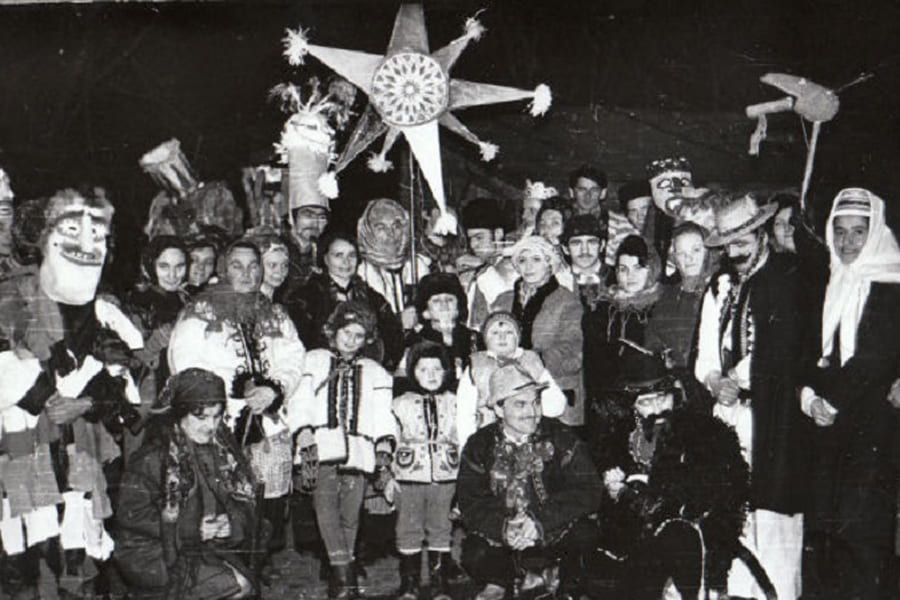
Ukrainian nativity scene during the USSR.
In Ukraine, carolers glorify Christ and wish people a Merry Christmas throughout the entire cycle of winter holidays.
The “Mosaic” project, spearheaded by Uliana Horbachevska, a dedicated researcher of traditional Ukrainian songs, is a prime example of a modern nativity scene. This annual Christmas concert draws its inspiration from traditional nativity performances. It features professional musicians and children’s groups who breathe new life into old carols with their experimental renditions. Ulyana organises “Mosaic” in various venues across Lviv, including churches and art spaces. In a notable shift in 2022, the concert was held for the first time in the city’s central square. Ulyana effectively transitions the carolling experience from an intimate family setting to a broader public sphere through this initiative.
Dissidents
Dissidents are people who in the 1960-80s in the USSR and other countries of the "social camp" questioned and criticised the official communist ideology and policy.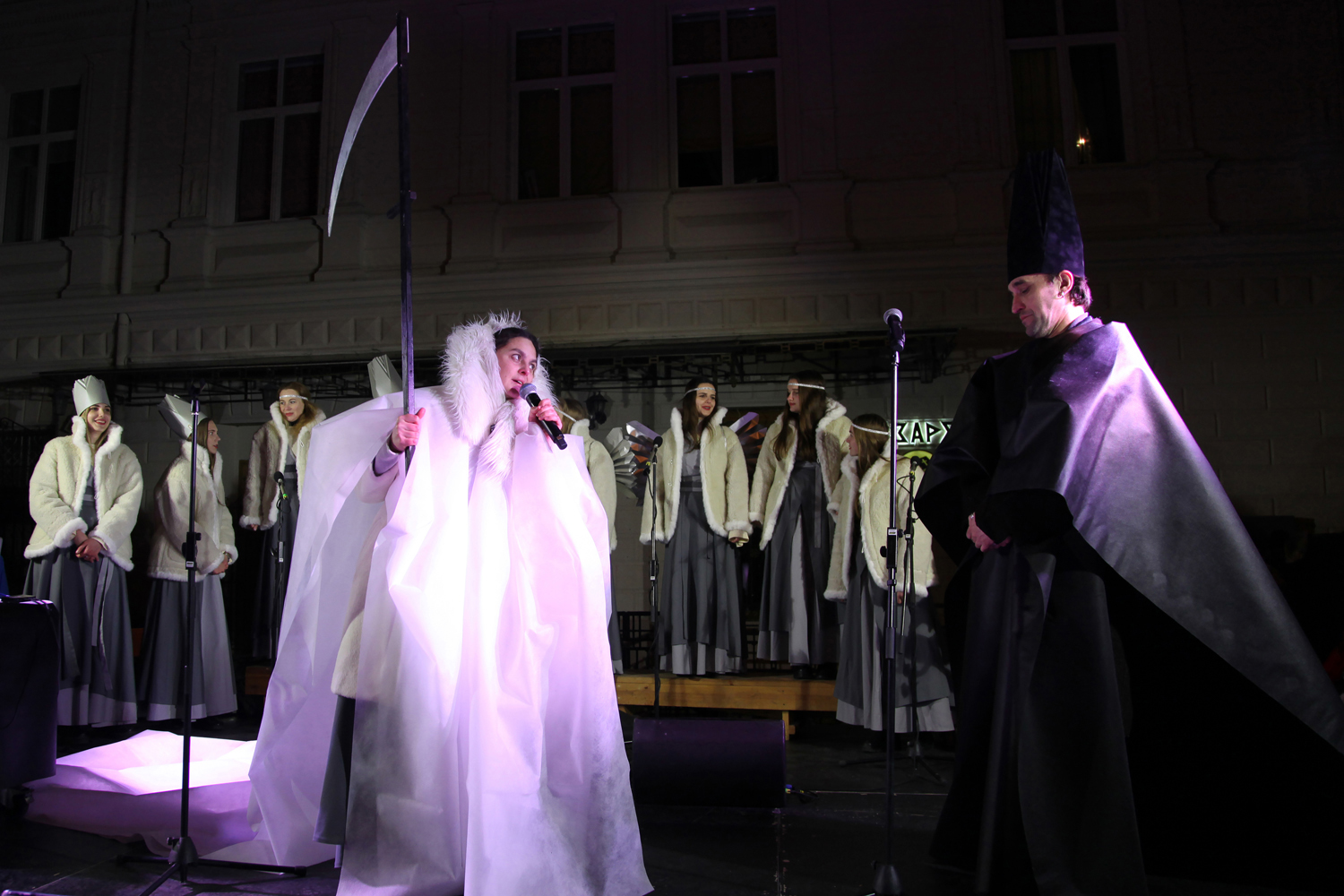
Christmas nativity scenes in Ukraine.
In 1989, the Ukrainian Youth Union played a pivotal role in reviving the tradition of nativity scenes in Kharkiv. That year, the first nativity performance was organised, and the tradition of carolling has continued uninterrupted since then. The nativity scene features a variety of characters, including the three kings, Herod and his warriors, Death, the Devil, Angels, Rachel, the host, and others. To authentically recreate traditional costumes, participants relied on books for guidance. They then crafted the costumes, drawing upon memories, illustrations, and photographs for inspiration.
Herod in Komarove
According to the locals, in the village of Komarove, which was part of the Polish lands for several centuries in a row, since those times, one special Christmas ritual has been preserved — it is called Herod. This is a nativity scene, the participants of which tell the story of the birth of God’s Son on behalf of King Herod.
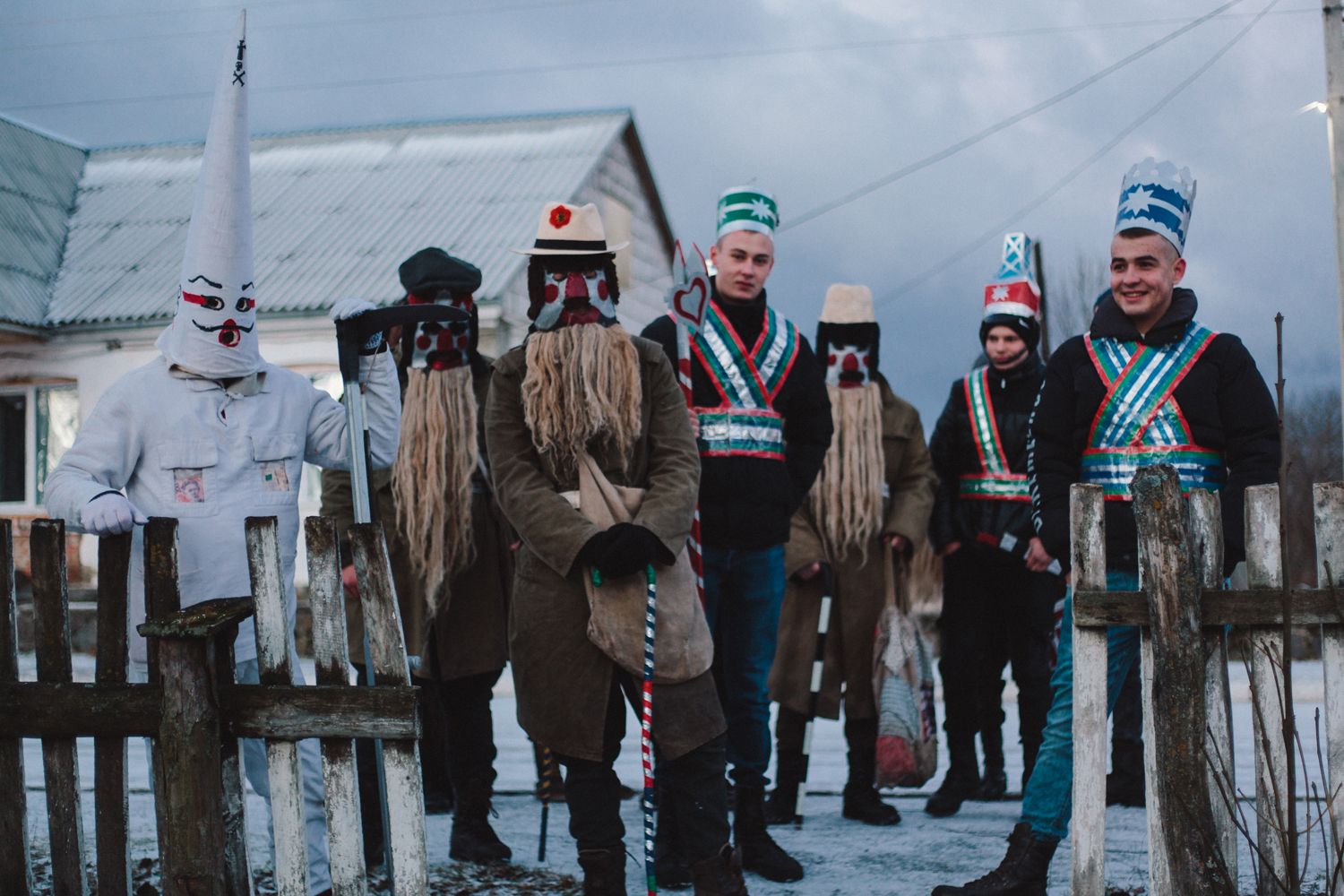
Christmas rituals and nativity scenes in Komarove, Ukraine.
Twelve unmarried young men take part in the nativity play. In two days, they go around the entire village, showing a nativity play in the houses following the route, laid out by their predecessors.
Basically, you can divide the participants of the nativity scene into direct participants and brawlers. During the performance, the main character (Herod) is surrounded by: Skorokhod, who travels around the world and brings news of the birth of a new king, the Son of Herod and the Angel who takes the Son after death; The Elder Warrior, who, by order of the King, but against his own will, kills the Son of Herod; and two Junior Warriors with sabres. Additionally, characters like the Devil or Death are often featured, usually capturing the most attention from children.
Skorokhod gathers the collected money, but brawlers resort to tricks and ask family members for a separate reward. They also stop cars and ask for a “penny”. If the drivers don’t give in, carolers start talking to them, joke, and still get the desired “penny”. Children come out of the yards to play with the Devil or run away from Death.
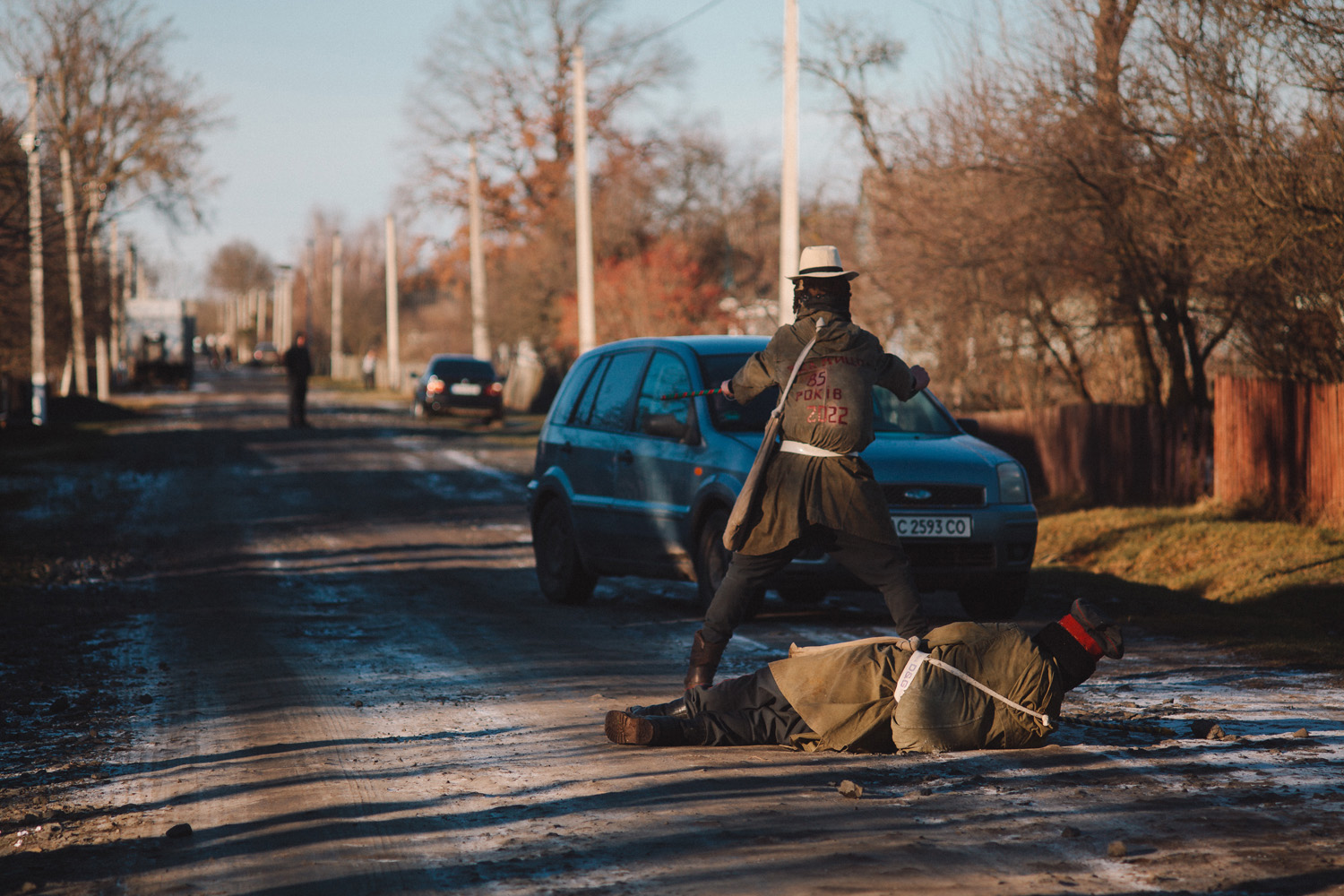
Christmas rituals and nativity scenes in Komarove, Ukraine.
Moșu în deal: Romanian Christmas tradition in Ukraine
In the village of Orlivka, situated just four kilometres from Romania and 20 kilometres from Moldova, where Romanian is the predominant language, a unique Christmas ritual known as Moșu în deal (Romanian for “An old man on the hill”) has been preserved. Moșu represents a spirit that, on Christmas night, is believed to ward off evil forces and bring prosperity to the household it visits. There remains a local debate about whether Moșu is inherently a benevolent or malevolent spirit.
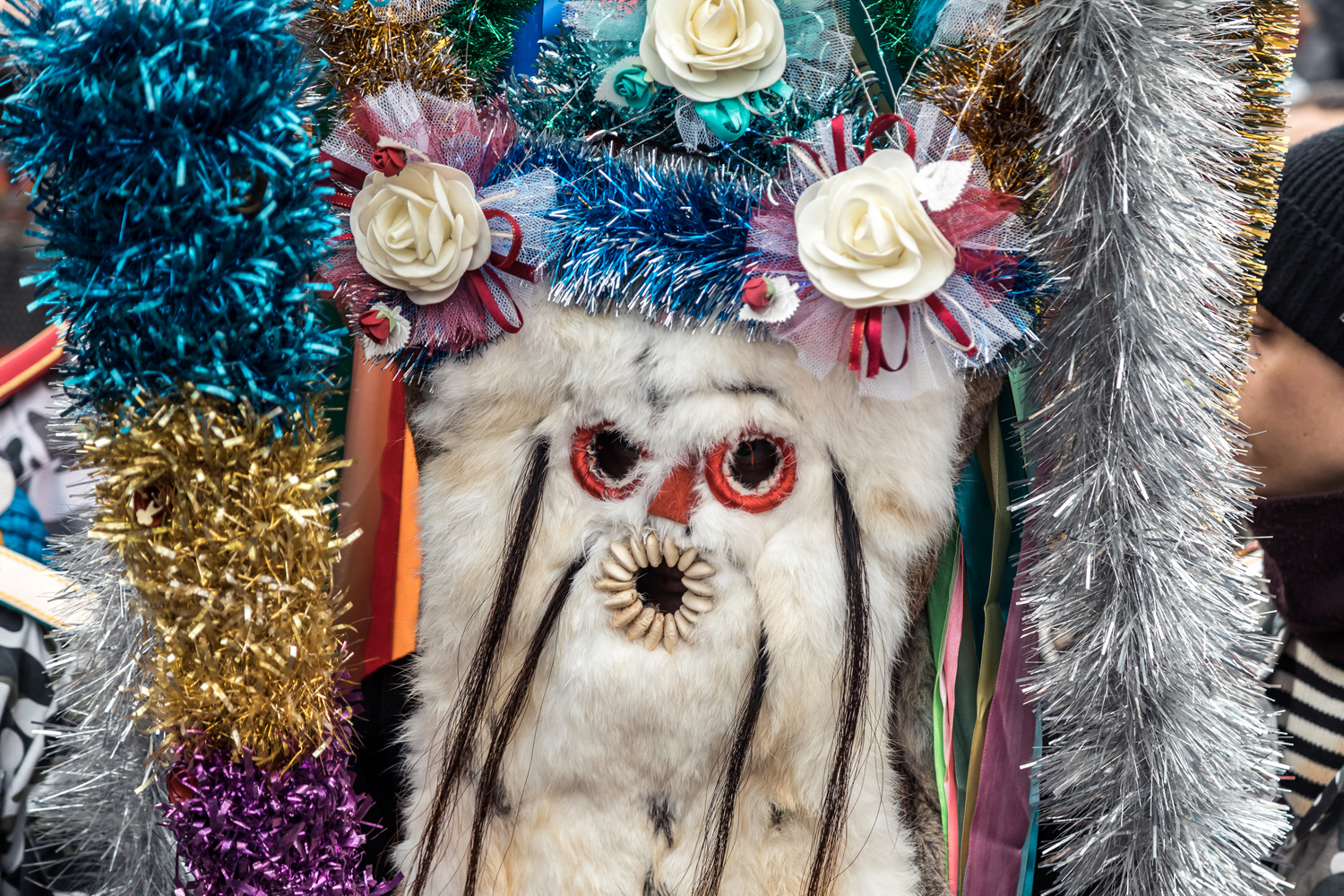
Moșu în deal in Orlivka, Ukraine.
The locals of Orlivka begin their preparations for the Moșu în deal in early December. They craft a Moșu mask using rabbit hair, embellishing it with flowers and ribbons. Additionally, they create costumes, rehearse carols, and practise the chora — a traditional round dance common among Bulgarians, Romanians, and other Balkan peoples.
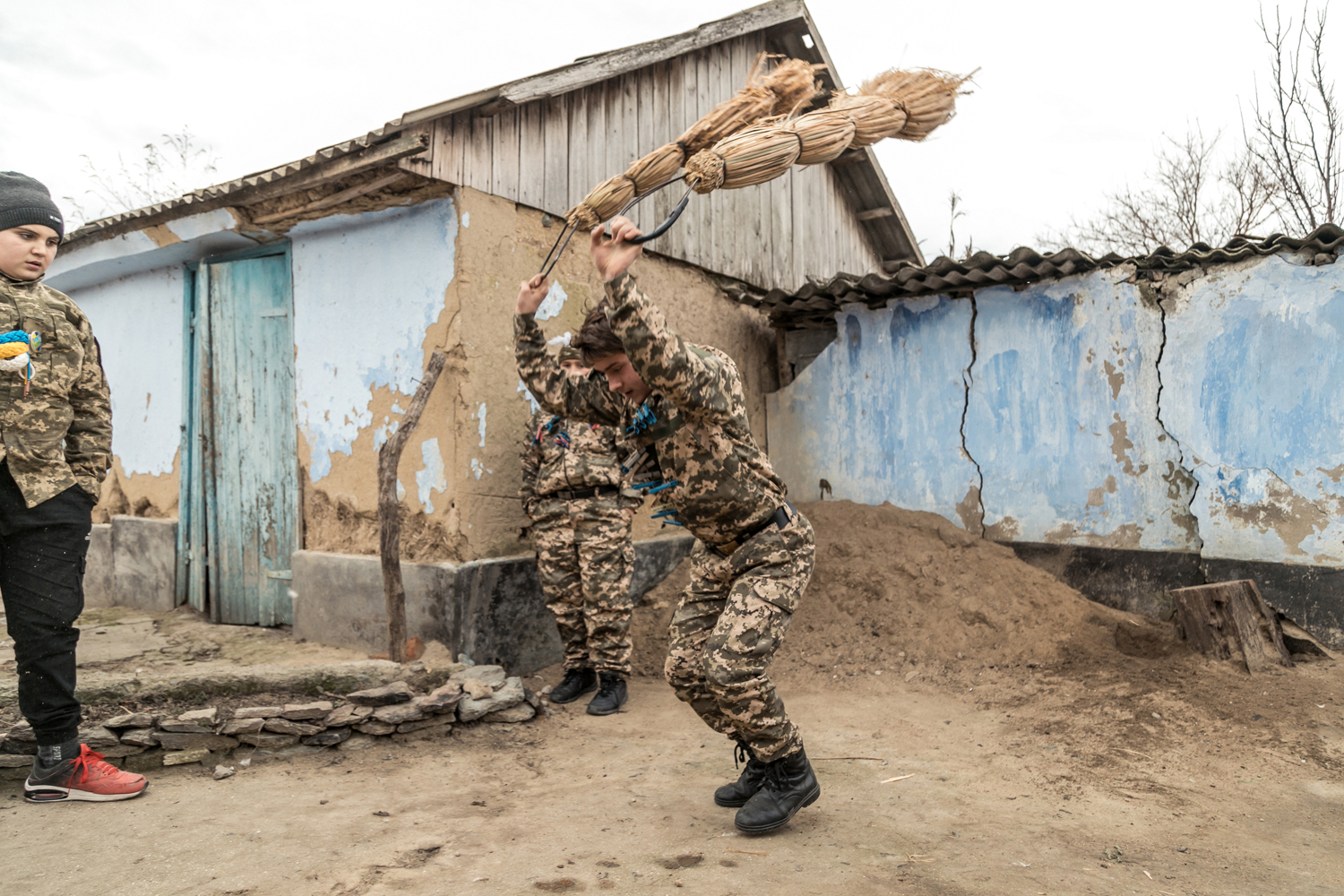
Moșu în deal in Orlivka, Ukraine
The ritual commences with carolers sprinting through the streets, momentarily stopping vehicles to extend holiday greetings to the drivers. Leading the procession is the senior band, dressed in sailor uniforms, heralding the arrival of Moșu’s spirit. They are followed by a junior group donned in military uniforms, directly guiding Moșu. The carolers engage with the drivers, inquiring about their names to sing them personalised carols.
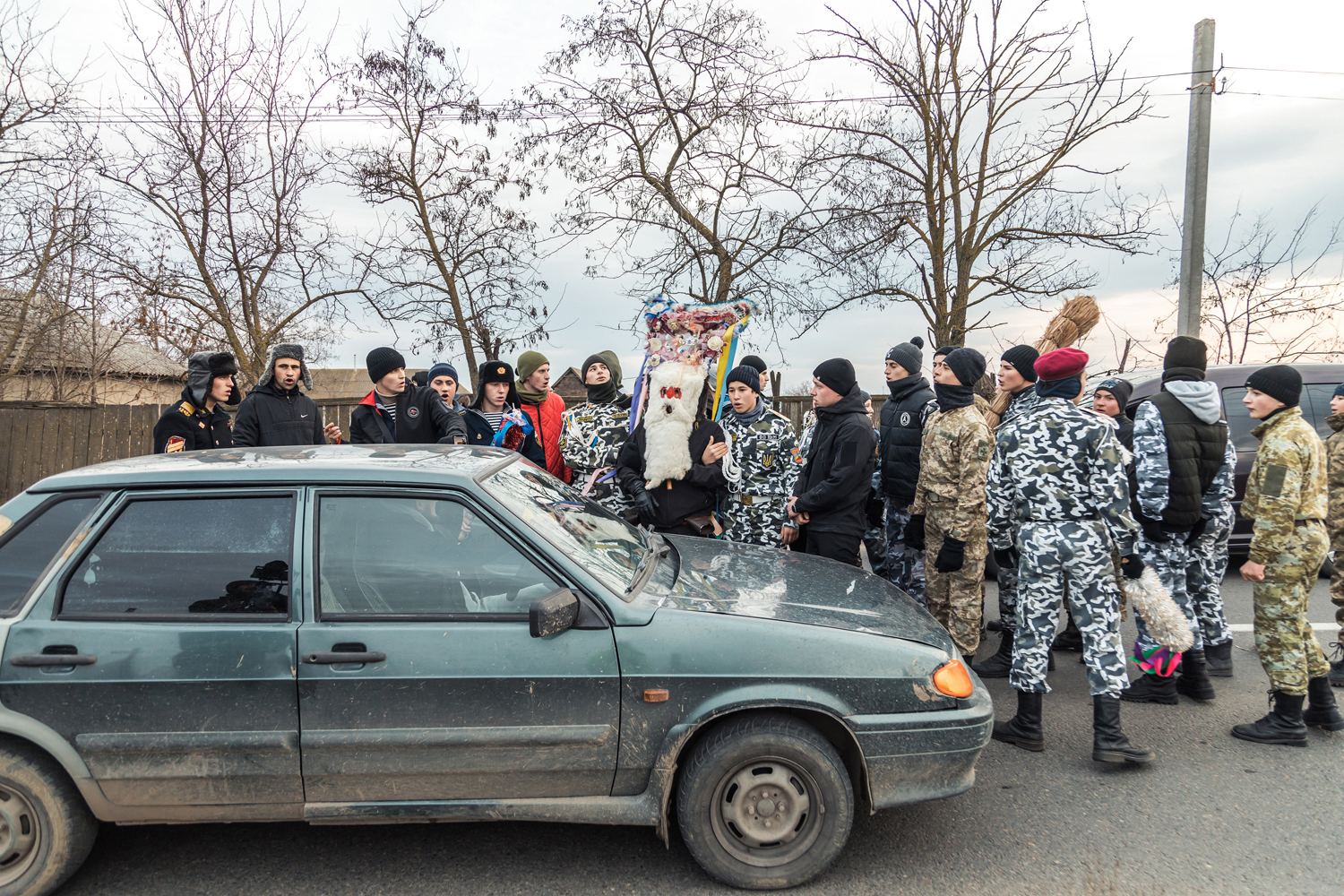
The owners thank the carolers with money, and sometimes with kalachy (pastry). If there is an unmarried daughter in the house, the owners should give the carolers this holiday bread, which they string on a stick.
All these foreplays lead them to the main event — the fight. The Moșus get together with sticks in a duel and push each other. They are helped by the group that holds the fighters by the legs. The winner is the one who knocks the other to the ground. Carol singers from both parts of the village welcome the village head and other distinguished guests, dance chora, sing joint carols and beat the mechuke on the ground even more fervently.
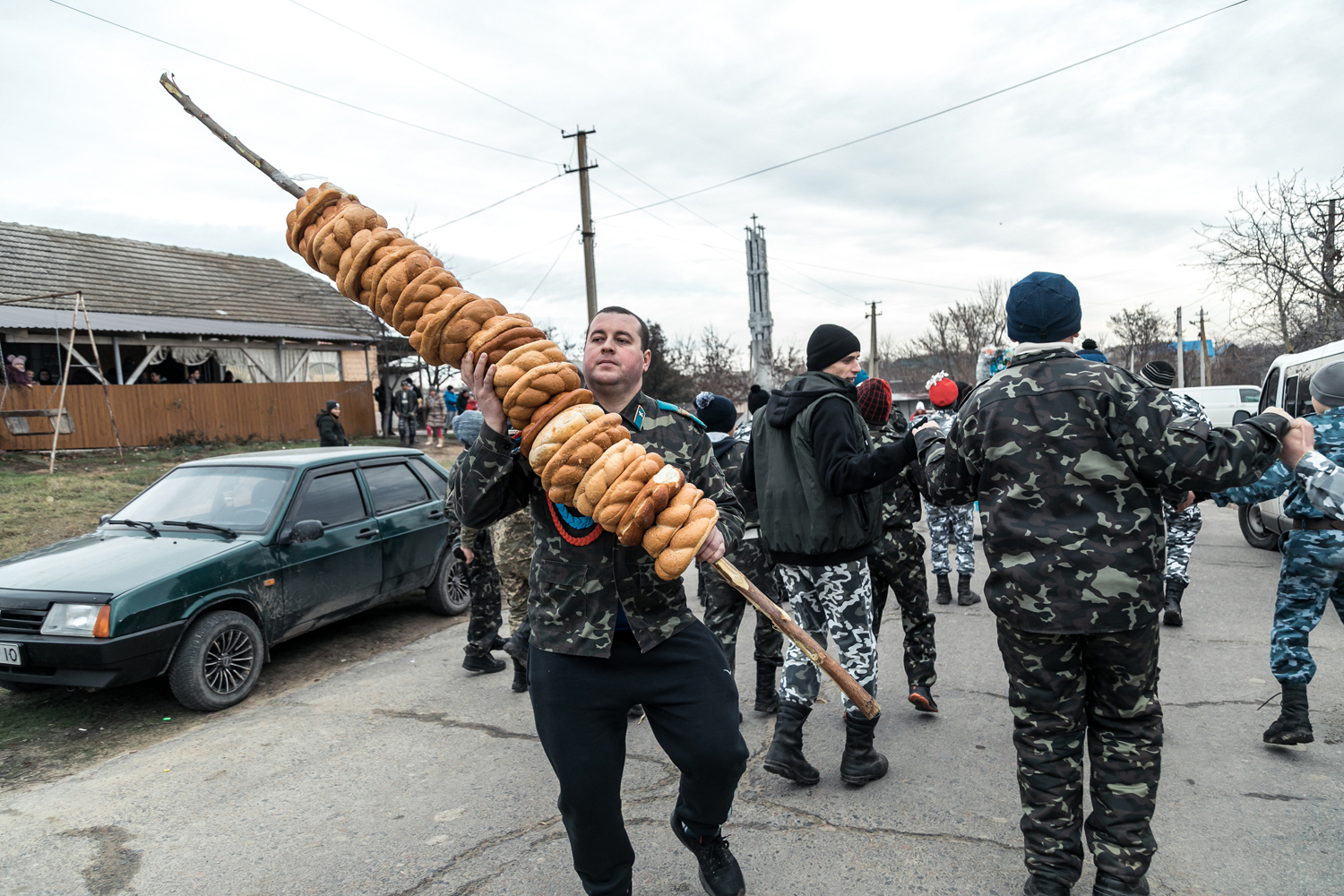
Distribution of kalachi (bread) during Christmas in Orlivka.
Then, they lift up Moșus for the last ritual — distribution of kalachi. Spectators reach their hands out and catch pieces of bread. The celebration in the centre of the village continues with a concert by local bands, and carolers organise a joint festive table for the money collected to celebrate the successful completion of the Moșu în deal ritual.
slideshow
Carolling in Ukraine during the Soviet times
During the Soviet period, bans on Ukrainian culture prevented the development of Ukrainian traditions, so their observance often took place secretly. The Soviet authorities restricted, and often outright prohibited carolling (as well as any public reproduction of Ukrainian traditions and rites), carolers were persecuted and arrested.
In those days, people would carol in the high mountains, away from prying eyes. The likelihood of anyone venturing into the mountains to check if people were carolling was minimal. However, in the cities, the situation was more complex. To avoid persecution by the KGB, some even rewrote the texts of carols, substituting references to Jesus with Lenin.
Ukrainian dissident Myroslav Marynovych shares his memories of organising a nativity scene in Kyiv:
— Back then, staging a nativity scene at Christmas was unthinkable. We went on 31 December and even disguised ourselves. Our leader, Mykola Matusevych, was arrested for 15 days. They provoked him into an altercation and then jailed him. Despite this, we continued carolling.
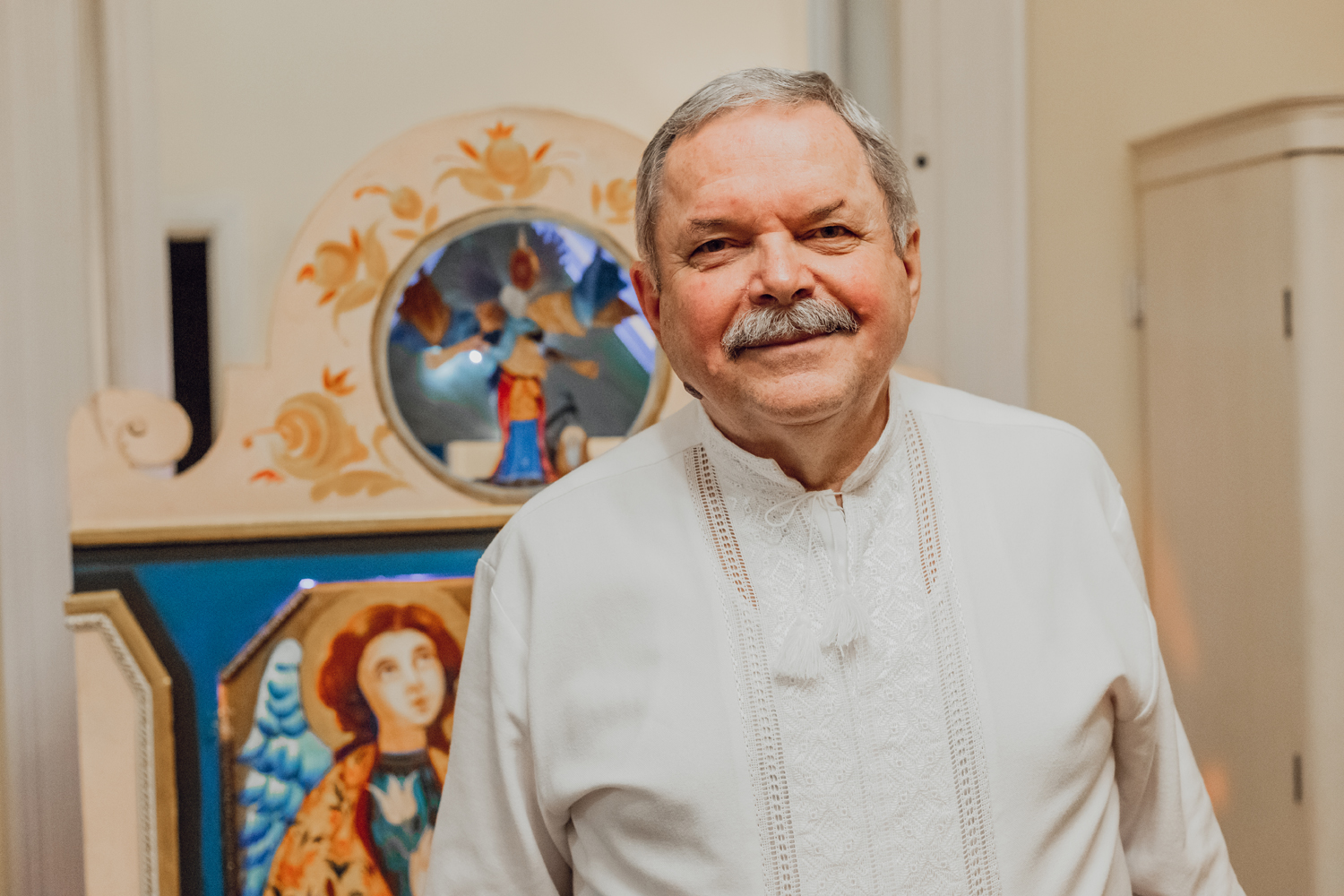
Ukrainian dissident Myroslav Marynovych
Both Matusevych and Marynovych were later arrested again and repeatedly summoned for questioning. Marynovych recalls that their carolling group had strict rules: carrying passports was mandatory, alcohol was prohibited, and they always moved in groups to prevent law enforcement officers from isolating and arresting anyone.
In Kharkiv during 1982-83, “parent groups” stood guard at house entrances during the Christmas carol period to ensure no unauthorised individuals entered.
Uliana Horbachevska from Lviv reminisces about her experiences:
— I remember the early 80s when I was in middle school or even younger. My godfather would put me, my sister, and my cousin, in his car and take us carolling to his relatives and friends. But only to those who were incredibly trustworthy and who would never betray us. That’s why, for me, Christmas has always been associated with something sacred and hidden, of immense importance.
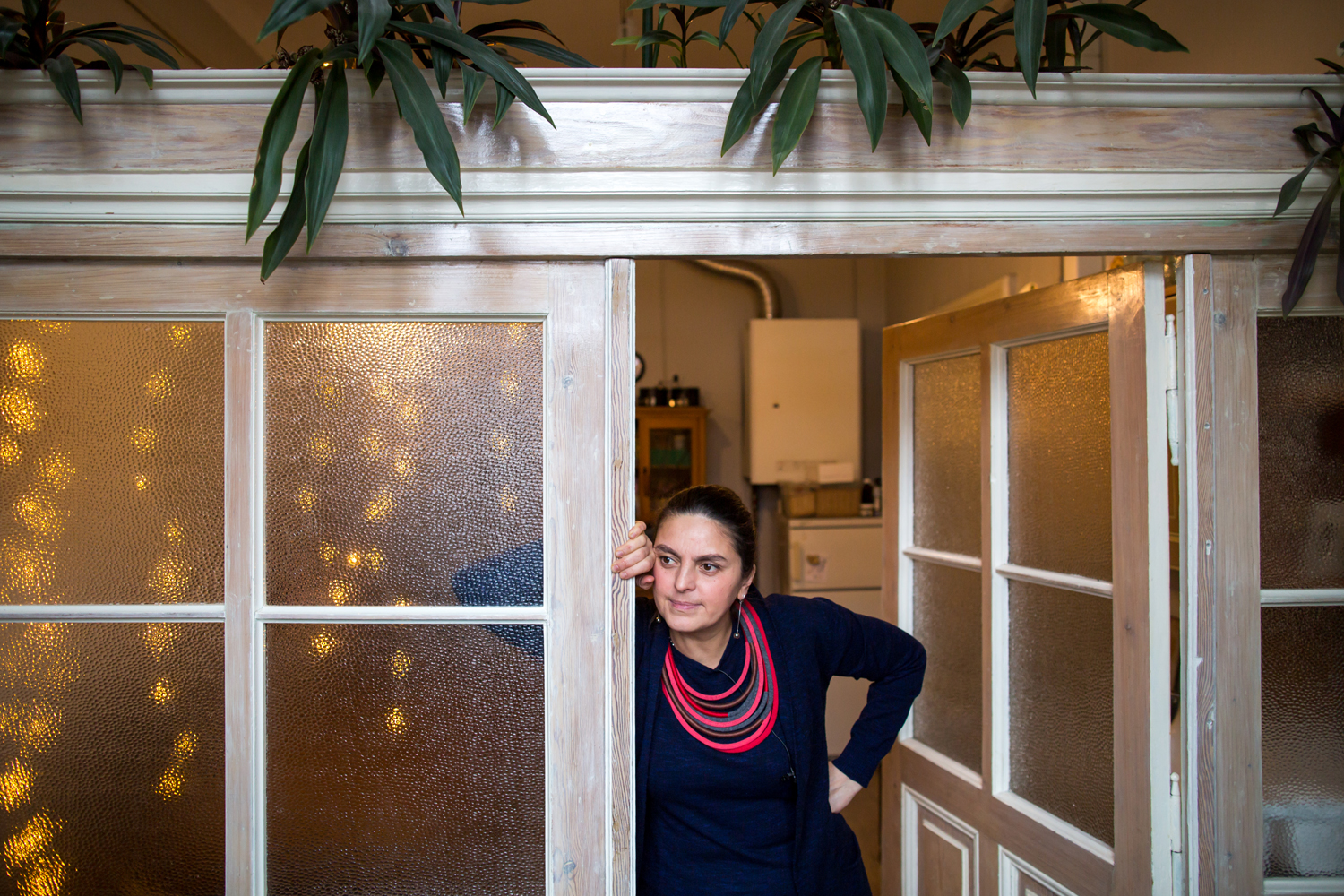
Uliana Horbachevska
The USSR government tried to destroy Ukrainian culture, just as the Russian authorities are trying to destroy everything Ukrainian today. Despite everything, Ukrainians continue to value their traditions and revive those that have been forgotten.

